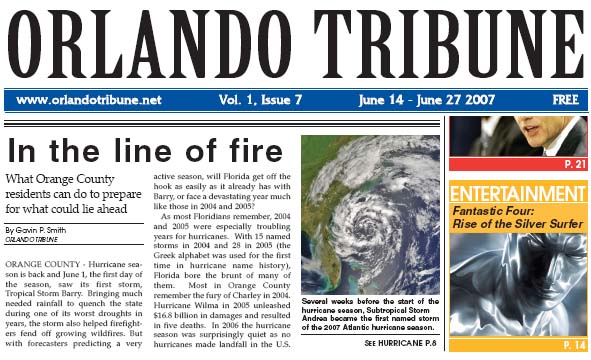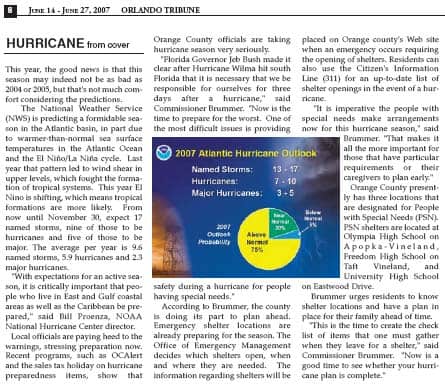What can you do to prepare for an active hurricane season?

ORANGE COUNTY – When an in-law that you just can’t stand comes for a visit once a year, the experience can be dreaded and stressful. A similar experience is upon us again. Hurricane season is back. The first day of the season began June 1st, and Florida has already seen its first storm, Tropical Storm Barry, forming on that very same day. Barry had much needed rainfall to help the state with one of its worst droughts in years, and helped firefighters fend off growing wildfires. But with forecasters predicting a very active season, will Florida get off the hook as easily as it already has with Barry, or face a devastating year much like those in 2004 and 2005?
As most Floridians remember, 2004 and 2005 were especially troubling years for hurricanes. With 15 named storms in 2004 and 28 named storms in 2005 (the Greek alphabet was used for the first time in hurricane name history), Florida took the brunt of many of them. Most in Orange County remember the fury of Charley in 2004. Hurricane Wilma in 2005 unleashed $16.8 billion in damages and caused 5 deaths. In 2006, the hurricane season was surprisingly quiet. No hurricanes made landfall anywhere in the U.S. last year. This year, the good news is that this season may indeed not be as bad as 2004 or 2005, but that’s not much comfort, considering the predictions.
The National Weather Service (NWS) is predicting a formidable season in the Atlantic basin, in part due to warmer-than-normal sea surface temperatures in the Atlantic Ocean and the El Niño/La Niña cycle. Last year, that pattern led to wind shear in upper levels, which fought the formation of tropical systems. This year, El Nino is shifting, which means tropical formations are more likely. From now until Nov. 30, expect 17 named storms, nine of those to be hurricanes, and five of those to be major. For a perspective, the average per year is 9.6 named storms, 5.9 hurricanes and 2.3 major hurricanes.

“With expectations for an active season, it is critically important that people who live in East and Gulf coastal areas as well as the Caribbean be prepared,” said Bill Proenza, the new NOAA National Hurricane Center director.
Local officials are paying heed to the warnings, stressing preparation now. Recent new programs, such as OCAlert and the sales tax holiday on hurricane preparedness items, show that Orange County officials are taking hurricane season very seriously.
“Florida Governor Jeb Bush made it clear after Hurricane Wilma hit South Florida that it is necessary that we be responsible for ourselves for three days after a hurricane,” said Commissioner Brummer. “Now is the time to prepare for the worst. One of the most difficult issues is providing safety during a hurricane for people having special needs.”
According to Brummer, the county is doing its part to plan ahead. Emergency shelter locations are already preparing for the season. The Office of Emergency Management decides which shelters open when and where they are needed. The information regarding shelters will be placed on Orange county’s website when an emergency occurs requiring the opening of shelters. Residents can also use the Citizen’s Information Line (311) for an up-to-date list of shelter openings in the event of a hurricane.
“It is imperative the people with special needs make arrangements now for this hurricane season,” said Brummer. “That makes it all the more important for those that have particular requirements or their caregivers to plan early.”
Orange County presently has three locations that are designated for People with Special Needs (PSN). PSN shelters are located at Olympia High School on Apopka-Vineland, Freedom High School on Taft Vineland, and University High School on Eastwood Drive. For special needs information and brochures, go to the Orange County Emergency Medical Services website at http://www.orangecountyfl.net/cms/DEPT/hfs/healthservices/ems/default.htm. The site has practical step by step explanation on how to be ready for the emergency.
What can you do to get ready? Know your shelter locations and have your plan in place for your entire family.
“This is the time to create the check list of items that one must gather when they leave for a shelter,” said Commissioner Brummer. “Now is a good time to see whether your hurricane plan is complete.”
There are a variety of online sources for hurricane information, tracking and preparedness information. Go online to the National Hurricane Center website at www.nhc.noaa.gov. As well, residents can find local hurricane preparedness information online at OCOEM.com. The site, online home of the Orange County Office of Emergency Management, features the All Hazards & Hurricane Preparedness Guide as well as other pertinent emergency information. As mentioned earlier, Orange County residents can take advantage of the new OCAlert system put in place to deliver severe weather warnings and emergency information via text messaging to email, cell phones, and other portable communications devices. Sign up for free at OCAlert.net.
